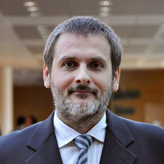prof. UAM dr hab. Krzysztof Gibasiewicz

2020
Szewczyk, Sebastian; Białek, Rafał; Giera, Wojciech; Burdziński, G; van Grondelle, Rienk; Gibasiewicz, Krzysztof
Excitation dynamics in Photosystem I trapped in TiO2 mesopores Journal Article
In: Photosynthesis Research, no. 0123456789, 2020, ISSN: 0166-8595.
Abstract | Links | BibTeX | Tagi: Excitation dynamics, Photosystem I, Primary charge separation, Synechocystis, Target analysis, Time-resolved fluorescence, Transient absorption
@article{Szewczyk2020b,
title = {Excitation dynamics in Photosystem I trapped in TiO2 mesopores},
author = {Sebastian Szewczyk and Rafał Białek and Wojciech Giera and G Burdziński and Rienk van Grondelle and Krzysztof Gibasiewicz},
url = {https://doi.org/10.1007/s11120-020-00730-1 http://link.springer.com/10.1007/s11120-020-00730-1},
doi = {10.1007/s11120-020-00730-1},
issn = {0166-8595},
year = {2020},
date = {2020-02-01},
journal = {Photosynthesis Research},
number = {0123456789},
publisher = {Springer Netherlands},
abstract = {Excitation decay in closed Photosystem I (PSI) isolated from cyanobacterium Synechocystis sp. PCC 6803 and dissolved in a buffer solution occurs predominantly with a ~ 24-ps lifetime, as measured both by time-resolved fluorescence and transient absorption. The same PSI particles deposited in mesoporous matrix made of TiO2 nanoparticles exhibit significantly accelerated excitation decay dominated by a ~ 6-ps component. Target analysis indicates that this acceleration is caused by ~ 50% increase of the rate constant of bulk Chls excitation quenching. As an effect of this increase, as much as ~ 70% of bulk Chls excitation is quenched before the establishment of equilibrium with the red Chls. Accelerated quenching may be caused by increased excitation trapping by the reaction center and/or quenching properties of the TiO2 surface directly interacting with PSI Chls. Also properties of the PSI red Chls are affected by the deposition in the TiO2 matrix: they become deeper traps due to an increase of their number and their oscillator strength is significantly reduced. These effects should be taken into account when constructing solar cells' photoelectrodes composed of PSI and artificial matrices.},
keywords = {Excitation dynamics, Photosystem I, Primary charge separation, Synechocystis, Target analysis, Time-resolved fluorescence, Transient absorption},
pubstate = {published},
tppubtype = {article}
}
Excitation decay in closed Photosystem I (PSI) isolated from cyanobacterium Synechocystis sp. PCC 6803 and dissolved in a buffer solution occurs predominantly with a ~ 24-ps lifetime, as measured both by time-resolved fluorescence and transient absorption. The same PSI particles deposited in mesoporous matrix made of TiO2 nanoparticles exhibit significantly accelerated excitation decay dominated by a ~ 6-ps component. Target analysis indicates that this acceleration is caused by ~ 50% increase of the rate constant of bulk Chls excitation quenching. As an effect of this increase, as much as ~ 70% of bulk Chls excitation is quenched before the establishment of equilibrium with the red Chls. Accelerated quenching may be caused by increased excitation trapping by the reaction center and/or quenching properties of the TiO2 surface directly interacting with PSI Chls. Also properties of the PSI red Chls are affected by the deposition in the TiO2 matrix: they become deeper traps due to an increase of their number and their oscillator strength is significantly reduced. These effects should be taken into account when constructing solar cells' photoelectrodes composed of PSI and artificial matrices.